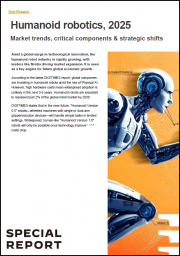
DIGITIMES 는 하드웨어 컴포넌트의 비용이 높기 때문에 휴머노이드 로봇은 향후 3-5년 이내에 다양한 산업에서 급속히 보급하기 어렵고, 주로 특정 용도 시나리오에 집중될 것으로 예상됩니다. 2족 보행이나 양팔의 고자유도 핸드 구조를 가진 휴머노이드 로봇의 규모가 보다 크게 성장하는 것은 기술과 규모의 경제가 진보하는 2029년 이후가 될 것으로 보입니다.
세계 로봇 수요는 노동자 부족과 비용 상승, 인더스트리 4.0의 진행, AI 기술의 통합 등 여러 요인에 의해 촉진되고 있습니다. 특히, 휴머노이드 로봇의 개발은 역사적으로 기술적 한계로 인한 높은 비용 제약을 받았습니다. 일부 기업의 지속적인 R&D 투자에도 불구하고, 휴머노이드 로봇은 대규모 상업화를 달성하기 위해 어려움을 겪고 있습니다. DIGITIMES 는 휴머노이드 로봇이 2025년 88억 달러로 예측되는 로봇 시장의 불과 0.2%를 차지하고 2026년까지 0.8%로 급증할 것으로 예측했습니다.
DIGITIMES 는 휴머노이드 로봇을 두 가지 유형과 두 가지 개발 단계로 나누어 정의합니다. 2025-2028년 세계 로봇 산업은 성숙한 산업용 로봇과 서비스 로봇을 넘어 물체를 핸들링하기 위한 그리퍼나 흡입 노즐을 갖춘 단팔 또는 양팔을 갖춘 바퀴가 달린 이동성을 가진 로봇으로 진화합니다. 이것은 "Humanoid Version 0.5"로 생각할 수 있으며 주로 특정 환경에서 간단한 작업을 수행하는 것을 목표로 합니다. 그러나 현재 휴머노이드 로봇의 비용은 동등한 능력을 가진 산업용 로봇을 훨씬 웃돌고 있기 때문에 제조업체는 휴머노이드 로봇을 대규모로 보유하기가 어렵다고 생각됩니다. 그 결과, 이 시기에 전개되는 휴머노이드 로봇의 수는 한정된 채로, 컴포넌트 비용의 삭감이 현 단계에서 휴머노이드 로봇 개발의 주된 과제가 되고 있습니다.
DIGITIMES 는 2029년 이후 기술의 진보와 규모의 경제에 의해 2족 보행 모빌리티와 고자유도의 양팔 손 구조 모듈의 비용이 대폭 절감되어 휴머노이드 로봇이 대량 생산에 적합한 단계에 들어갈 것으로 예측했습니다. 이 "Humanoid Version 1.0"의 단계에 있는 로봇은 2족 보행 이동성과 손쉬운 손잡이를 가진 양팔을 포함한 완전한 구성을 갖추고 보다 복잡한 작업을 수행할 수 있게 됩니다. 이 개발은 휴머노이드 로봇의 보급이 가속화되고 그 용도가 산업 환경에서 서비스 지향 환경 및 기타 시나리오로 확대될 것으로 예측됩니다. 인간과의 협동과 상호작용을 수반하는 장면이 늘어남에 따라, 휴머노이드 로봇의 개발은 하드웨어나 소프트웨어의 요소뿐만 아니라 안전 규제도 중요한 고려 사항으로서 중시할 필요가 있습니다.
본 보고서에서는 휴머노이드 로봇의 개발 동향을 조사하고 개발자의 전략과 응용 시나리오를 분석함으로써 산업 동향의 배경과 주요 과제를 밝히고 있습니다. 또한 소프트웨어(AI), 하드웨어(컴포넌트), 안전규제 등의 분야에서 과제와 잠재적인 솔루션을 파악하고 있습니다.
DIGITIMES believes that due to the high cost of hardware components, humanoid robots can hardly see rapid adoption across various industries within the next 3-5 years and will primarily focus on specific application scenarios. It will not be until after 2029, with advancements in technology and economies of scale, that humanoid robots with bipedal mobility and dual-arm high-degree-of-freedom hand structures may experience more significant growth in scale.
Global demand for robots has been driven by multiple factors, including labor shortages and rising costs, the advancement of Industry 4.0, and the integration of AI technologies. In particular, humanoid robot development has historically been constrained by high costs due to technological limitations. Despite continued R&D investment by some companies, humanoid robots have struggled to achieve large-scale commercialization. However, with significant advancements in AI applications in recent years, substantial capital and talent have poured into the commercial humanoid robot sector. DIGITIMES estimates that humanoid robots will account for only 0.2%of the projected US$8.8 billion robot market in 2025, but their share is expected to surge to 0.8% by 2026.
DIGITIMES defines humanoid robots in two types and two development stages. From 2025 to 2028, the global robotics industry will evolve beyond mature industrial and service robots towards robots with wheeled mobility equipped with single or dual arms featuring grippers or suction nozzles for object handling. This can be considered as "Humanoid Version 0.5," primarily aimed at performing simple tasks in specific environments. However, since the cost of humanoid robots currently far exceeds that of industrial robots with comparable capabilities, manufacturers find it difficult to afford large-scale adoption of humanoid robots. Consequently, the number of humanoid robots deployed during this period remains limited, making the reduction of component costs a key challenge for the development of humanoid robots at this stage.
DIGITIMES estimates that after 2029, advancements in technology and economies of scale will significantly reduce the cost of modules for bipedal mobility and dual-arm high-degree-of-freedom hand structures, making humanoid robots enter a stage suitable for mass production. Robots in this "Humanoid Version 1.0" phase will feature complete configurations including bipedal mobility and dual arms equipped with dexterous hands, enabling them to perform more complex tasks. This development is expected to accelerate the adoption of humanoid robots, expanding their applications from industrial settings to service-oriented environments and other scenarios. As scenarios involving collaboration and interaction with humans increase, the development of humanoid robots will need to focus not only on hardware and software factors but also on safety regulations as a key consideration.
This research report will explore the development trends of humanoid robots, analyzing developer strategies and application scenarios to uncover the context of industry trends and key challenges. It will delve into issues and challenges in areas such as software (AI), hardware (components), and safety regulations, along with potential solutions. Based on these findings, it will outline short-, mid-, and long-term development trends for the humanoid robot market.
Looking ahead, driven by AI, humanoid robots as part of Physical AI will also significantly impact and transform industries. The core key lies in when it happens, where it originates, and how it unfolds, which leads to clear market goals but a journey filled with uncertainties. These are precisely the central issues explored in this research report.